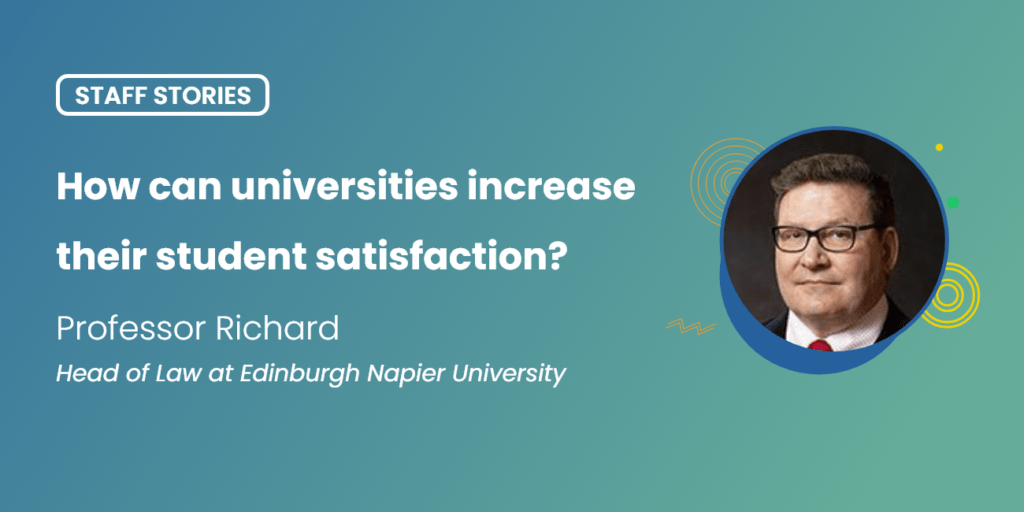
Student satisfaction is crucial for universities. It helps them attract top student talent, and it has a direct impact on a University’s reputation and success.
Unitu had the great opportunity to interview Professor Richard Whitecross, who shared with us his inspiring story, valuable insights and best practices on how his university was able to retain high student satisfaction.
Introducing our Interviewee
Professor Richard Whitecross is the Head of Law and Professor of Law at Edinburgh Napier University. He is the University lead for the Professional Doctorate and a member of the Business School Core Executive.
Was there ever any trouble with NNS scores?
Richard: One time we went down from 90% to 80%, but I know why it happened — there was an issue in trimester one raised by students in both years that wasn’t being addressed.
Students weren’t being kept informed, but also the Head of Subject just wasn’t interested. The students made it clear that they felt they weren’t being listened to or respected.
The bigger concern was that the issue was never even resolved, so of course, NSS came along, and what can you do.
What have you learned from previous experiences?
I’ve learned to be more open this year, and encouraged others to do the same.
I tackle things with more transparency — tell students what you’re going to do, why you’re going to do it and when you’re going to report back by; this gives people a sense that you’re listening.
From past mistakes, the key takeaways were to be more open and transparent with students. I’ve noticed the impact it’s made and we’ve done fairly well in NSS because of it.
How do you organise your University to deal with issues effectively?
We now have student reps for every individual module for greater coverage, and tutors are touching base with their students on a more regular basis.
This means we can escalate issues more sensibly, starting with the module leaders, then the two deputy program leaders, the program leader and, as a last resort, me.
These are positions we have recently put in place, so we can deal with issues faster and more effectively.
How do you give students a sense of satisfaction?
Show students you’re someone approachable and willing to listen.
When responding to them, get your messaging right — and if you don’t know how to respond, you simply say: I don’t know or I’m looking into it.
Always give them a sense that you’re listening; that you’ve got their email, you’ve read it, you’ve thought about it and you’re looking into it.
It makes a difference, and even if you don’t know how to reply, you still keep them satisfied.
How do you respond to direct requests from students?
When students come to me directly for things, I’m able to deal with things quicker.
I simply say, we’ll set up a meeting face to face, instead of going back and forth trying to clarify things through emails.
Having 10 to 15 minute conversations can make the lives of academics much easier, because it takes forever to write an email that actually leaves a student satisfied.
Are face to face conversations worth it?
Yes, you can cover more ground, and you can also tell how someone feels.
Sometimes you get presented with a problem, but actually it’s not the real problem. You might get the feeling something isn’t quite right, and you’re able to ask, “what’s wrong?”
The real problem could be about the student’s home life, emotional life, health, or finance — direct them to the right support and make a real difference.
Encourage your colleagues to also have the confidence to ask, “What’s wrong?”
What is good practice to keep students engaged?
Personally, I tell students I’m having a virtual coffee morning and that they can pop in if they like.
I adapted to the pandemic and found ways to consistently engage with students, if it’s in person or online.
Create opportunities for them to give feedback, but also reach out and try to engage with them. Create a sense of community by communicating and engaging with students informally.
How do you keep staff consistently responding to students?
It’s hard getting staff to ask students: “What’s working well?” “What’s not working well?” “What are the issues?”
They’re not necessarily big tasks, but staff simply don’t like listening to complaints, they don’t want to hear the grumbles.
But unfortunately, the grumbles exist and they need to be faced.
I focus on staff behaviors, and I mirror the behaviors I would like to see in my colleagues. I make sure myself and staff are responding to students within two working days, as the timing of responses is really important.
What’s the main reason you teach?
We’re equipping students with the skills to deal with the world — that’s what really engages me.
I love seeing people develop, I love seeing confidence grow in people, and having them come back and tell me what amazing things they’ve gone on to do.
I’m not bothered about someone’s grades, I’m more interested in them developing.
Students really are our future, so let’s value what they’re saying and think about ways we can help them develop.
We hope that the insights shared by Professor Richard Whitecross will be helpful and inspiring for other higher education professionals in the sector.
Key takeaways to remember:
– Communication: communicate and explain to students the reasons behind why and how things are done.
– Feedback: create opportunities for students to give you feedback and give them a sense that you’re listening by showing them how you’re acting upon it.
– Engagement: if it’s formally, informally, online or in person — always reach out and engage with students, and remind them that you’re there for them.
